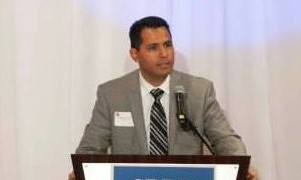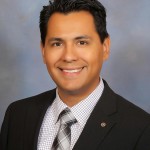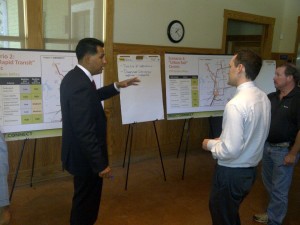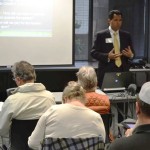
By Elizabeth McGuire
Two weeks into his new job as Chief of Staff for Mayor Steve Adler, John-Michael Cortez‘s office showed clear signs of a recent occupant. The walls and bookshelves were bare except for a few colorful drawings from his young daughter. Cortez explained they were still rearranging offices so he didn’t want to unpack twice, but the sparseness would be understandable regardless. Who has time to decorate with a job that has kept him moving since day one? Cortez seems to thrive on this fast pace. In fact, you get the impression he has been in nonstop motion his whole career, juggling full-time jobs with board positions for multiple nonprofits.
 Cortez grew up in Austin and attended the University of Texas as a third-generation Longhorn. He graduated from UT’s McCombs School of Business and received a Masters of Science in Community and Regional Planning from UT’s School of Architecture.
Cortez grew up in Austin and attended the University of Texas as a third-generation Longhorn. He graduated from UT’s McCombs School of Business and received a Masters of Science in Community and Regional Planning from UT’s School of Architecture.
Before joining the mayor’s office, Cortez was Manager of Community Involvement for Capital Metro. He has served in various leadership positions for dozens of community organizations and efforts, including the Center for Public Policy Priorities, Community Advancement Network and Austin Community College District. In 2008 he and his wife, along with several friends – including a few Leadership Austin classmates, created FuturoFund, a giving circle that cultivates the next generation of Hispanic leaders.
Though his new position keeps him running, Cortez made time to sit with Leadership Austin and discuss his path to this new job and what’s ahead for him.

Tell us about your earliest career…
I grew up working in my family’s restaurants. Some people wouldn’t claim that as the start of their career, but it was very formative for me. I might say, you can’t claim to be a true Austinite unless you’ve worked in the service industry at some point. The job developed a strong work ethic, and since it was my family’s place it also instilled in me the value of entrepreneurship, which was something I dabbled with later in my life.
I really lean on that experience a lot because it teaches you how to communicate with people, no matter their mood. You have to accept them no matter what situation they are in, and still provide good service. Plus, at a young age I was managing a store so that helped with leadership and management. I really do think that was a foundational experience for me. So I started there and then got into consulting after graduation.
How did you find your career in civic work?
While I was still at UT, I joined the Hispanic Chamber of Commerce and got involved in the education committee. I had received a lot of scholarships, which allowed me to go to school, so I volunteered for that and was able to give back in a way. I got my first lesson in leadership: If you show up to all the meetings, eventually they ask you run the committee. I volunteered with the scholarship program, then eventually started chairing the committee and eventually got on the board at a pretty young age. During that time I was interning for a consulting firm called Strategic Partnerships. They hired me when I was done with school.
When I left Strategic Partnerships, it was because I needed to scratch that entrepreneurial itch. I started a company with my grandfather. Meanwhile, I was doing lots of volunteer work. As that business wound down, I realized I had no passion for the job I was doing, but I really enjoyed the community work I was doing. So I really wanted to find a way to get paid to do that.
At the time I was on the planning commission and the more I learned about land use and community development, the more engaging and interesting it was to me. I started looking at the consensus that was developing about how our community should grow. More and more I began to see public transportation as an absolutely essential piece of that. I really wanted to help Capital Metro and be a part of working along with others to put it in a position where it could…realize this vision of how we wanted Austin to grow as a community.
Where was your career when you joined the Essential Class of 2008? What drew you to it?
I was at Capital Metro, but I hadn’t been there very long. I had a number of friends and colleagues who had been a part of it. Matt Curtis was my boss and he suggested it. In the community leadership and service I had been involved with, you run into Leadership Austin folks all the time, and it seemed like a great thing to be a part of it. I had gone through the Hispanic Chamber leadership program, so this seemed like a natural thing to do.
What experiences from Leadership Austin have stuck with you?
So much of the program is about the relationships you develop. I’m still great friends with many of the people from my class. One lesson learned was to question assumptions about people and backgrounds. At times, we all fall into that trap that we need to be shaken out of. I found the program to be incredibly worthwhile and I still do. I write one or two recommendations for applicants every year.
How would you describe your leadership style?
Collaborative. I really believe that the best decision making is participatory. That has been my professional background for that last 7 to 8 years…engaging people in decisions that impact them. Whenever I’ve worked with teams of people I’ve tried to make it about what the group thinks is the best course of action. At the end of the day one person is typically accountable, but I think by involving the people who either have to implement the decision or who suffer the consequences or who plan a project…the results are almost always better when it’s a collaborative decision-making process.
I also think that a good leader enables other leaders. Whenever I hire anybody, I look for leadership and passion. Everything else can be figured out. If that person doesn’t come in with the ability to lead in whatever way they like to lead, and they aren’t passionate, then it doesn’t matter how smart they are.
Any advice for Austin leaders?
Listen. Listen more; talk less. This is something I have to remind myself every day. We don’t have all the answers. We need to make an effort to get beyond our bubble. My sense is that most discussions about Austin’s problems have happened within a bubble, and lack perspective. For example, there has been an awful lot of hand-wringing on development downtown, but nobody is paying attention to what’s happening off Parmer Lane or Ben White. You can’t really screw up downtown. You can make it more annoying for people, but you can’t do much damage because so much of it was done right the first time. A lot of the challenges we face are happening in places people aren’t paying attention to. Downtown is so visible and we see all the cranes, but this is not where our most significant challenges are.
Specifically on Austin…We like to hold ourselves out as a progressive city. I think people confuse our tolerance with a progressive mindset. We are a very tolerant city…we tolerate different ethnicities, different lifestyles, different orientations, but that’s not the same as being progressive. Austin may be more progressive than some other cities in Texas, but that’s quite frankly a low bar. There are a lot of great people doing wonderful things, and their success should not be discounted, but we cannot fall into the trap of believing all our own press. We still have very serious problems to solve.
 What are your hopes for Austin as we begin this new era of 10-1 government?
What are your hopes for Austin as we begin this new era of 10-1 government?
I think my hopes are the same as all the folks who worked on it. I hope that more people will be engaged with the decisions–because we need them to be. I hope that we do hear more voices than we’ve heard in the past. Again, getting outside our bubble. There’s so much talk about central Austin. Most of Austin isn’t central Austin. We need to hear those voices.
I hope it gives us the opportunity to reset some of the discussions we’ve had. Decision-making on big projects or policies tend to have a lot of momentum, so once they get going down a path it’s hard to stop and reassess. Sometimes we have to stop and ask whether we are still headed in the right direction. You have to balance that with the risk of paralysis by analysis. It’s a struggle.
What’s the most rewarding part of your work?
When people feel like they really impacted a decision. When compromise is reached in a positive way. I’ve been able to build some positive partnerships among organizations that didn’t really have great partnerships before. When you can make meaningful progress toward solving meaningful problems, I think that’s what we’re here for.
Anything else you would like to share about leadership?
We don’t have to worry too much about Leadership Austin participants being uninformed and unengaged, but I think it’s important to go that next step to bring other people to the table. It can’t just be us being informed and engaged. My sense of it is that there are people who are very engaged but the engagement is deep, not broad.
Something I’ve had to learn in the last 3 to 4 years is to focus and prioritize. I was on 12 boards when I met my wife. I thought I was doing a lot. I wasn’t doing as much as I thought I was, because I wasn’t focused. I’ve now tried to focus so I can have the most meaningful impact. It’s about managing your time realistically, managing expectations, and learning to say no.
But 12 boards…this is actually a problem. There is nothing particularly special about me. When I was serving on so many boards, I didn’t have a lot of experience or power or money. But I got asked. There are so many people out there with the time, the talent, the passion, the wherewithal to do these things, but they just aren’t being asked. We need to broaden the number of people who are engaged in those kinds of things. It’s a pathway to leadership. I wouldn’t be here if it hadn’t been for those opportunities.
